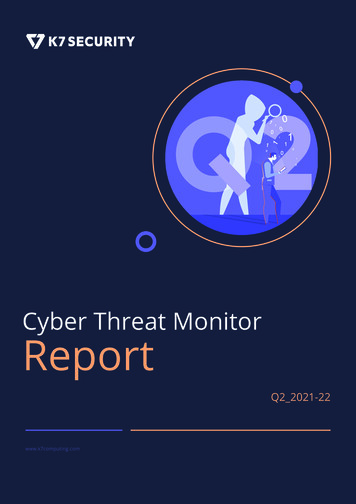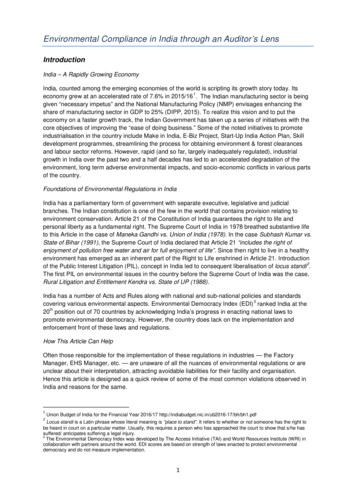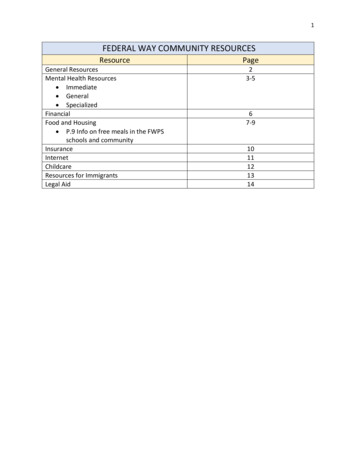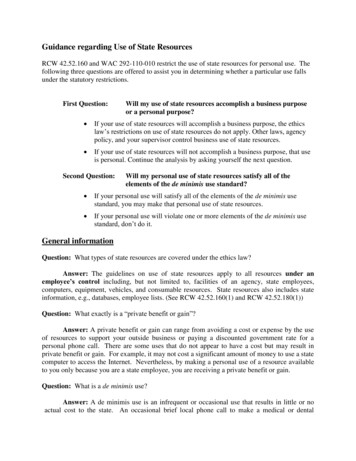
Transcription
22Cyber Threat MonitorReportQ2 2021-22www.k7computing.com
P. 2Contents03.A Glimpse into the Cyber Threat WorldCyber Threat Monitor India05.Regional Infection ProfileInfection Rate Comparison across PlatformsCase Study 1: Lemon Duck Miner Wreaking Havoc09.Enterprise InsecurityCase Study 2: Adhubllka Brute Forcing itself intoUnsecured DevicesSafety Recommendations13.Vulnerabilities GaloreRCE Vulnerability in Windows Printer SpoolerVulnerability in Kaseya VSASonicWall Products Affected by Buffer Overflow VulnerabilityWindows DNS Server RCE VulnerabilityCritical Vulnerability in Microsoft’s Trident EnginePrivilege Escalation Vulnerabilities in HP and Samsung Printers15.Danger in the Internet Of ThingsVulnerabilities in NETGEAR Smart SwitchesDevices Exploitable by Zero-Click ForcedEntryMitigation TechniquesWindows Malware Type Breakdown18.Windows Under SiegeWindows ExploitsHost Intrusion Prevention System HeuristicsMitigation TipsCase Study: No Joking Around with JOKER21.The Mobile Device StoryThe Ubiquitous TrojanThe Adware ImpactTips to Stay SafeThe Trojan Brouhaha24.Mac AttackThe Adware SagaA Trickle of PUPsSafety Guidelines27.Key TakeawaysK7 Cyber Threat Monitor
P. 3A Glimpse into theCyber Threat WorldEven after the continuous plunge in the number of recorded casesis yet to be updated. Unfortunately, both these software providers andworldwide, the dreadful Covid-19 is not over yet. The glimpse of lighttheir consumers misjudge the severity, and thus unknowingly inviteat the end of the tunnel, so to speak, is the growing awareness amongmalware attacks.global citizens to combat the SARS-CoV-2 strain by getting vaccinatedand following the prescribed safety protocols. We wish the same couldhappen among the netizens concerning digital hygiene.Despite several warnings and words of caution by the cybersecuritysolution providers, a significant part of the netizens are still casualabout basic cyber hygiene practices. Unfortunately, similar ignoranceis practiced by innumerable SMEs, SOHOs, and startups. And evenworse, many of them still do not seem to understand the probableloss they could bear if a threat actor successfully victimised them.This can be seen from the fact that some of them still use dated systemssuch as using Windows 7 or Windows 8 powered computers forindustrial productions. One of the primary reasons why they fail to shiftto more secure versions is that some of their application software issupported only on these operating system versions and their softwareK7 Cyber Threat MonitorIn the past three months, our researchers uncovered hundredsand thousands of thwarted attacks inside and outside the country.Interestingly, a significant part of these attacks were due to unpatchedold vulnerabilities such as SMBV3.In this era of unprecedented uncertainty, countering such risksrequires a cooperative effort involving end-users and enterprises alike.That is perhaps the only way to strengthen the bond between thesecurity providers and the consumers to manage risks effectively. It’stime to take the first step towards this initiative.Happy reading, stay safe and stay healthy!We would appreciate you sharing this report among your colleagues andfriends to raise awareness of the prevalence of cyber threats, thus helpingto make the digital world a safer place!
P. 4Cyber Threat ok45%PatnaLucknow d42%Chennai42%Port Blair41%Puducherry46%40% - 45%35% - 39%30% - 34%Map for illustrative purposes only. Not to scale.K7 Cyber Threat MonitorBack to contents
P. 5Regional InfectionProfileOver 30 years, K7 Computing has successfullyTo better understand the present condition ofsafeguarded millions of clients globally from variousthe domestic threat landscape, we have designedcyber threats. The cyber threat monitor report offersa concept called Infection Rate (IR). The idea isa snapshot of the threats observed during eachpicturised as follows.quarter.Infection Rate (IR) of an areaK7EcosystemThreatIntelligenceUpdate NotificationBlocked Threat EventNotificationK7 Users at location XYZThe overall Pan-India IR in comparison withthe previous quarter is given below41%Q1 2021-2245%Q2 2021-22The sustained steady escalation of infection rateThe threat type breakdown for the Windows OSaround the country has become a standard for manyacross Metros and Tier-1 cities is as depicted below.years. This quarter was no exception either.K7 Cyber Threat MonitorInfection Rate at XYZ4/50 8%
P. 6The Metros and Tier - 1 Cities - Infection 44%41%Pune55%52%Behaviour ProtectionK7 Cyber Threat u54%27%14%28%Firewall ProtectionScanEngine ProtectionWeb Protection
P. 7Tier-2 cities are also facing an increase in threats asshown in the proportion of thwarted attacks.Top 15 Infection Rates in Tier - 2 Cities3634K7 Cyber Threat ta in %45413634Back to contents
P. 8Infection Rate Comparison across PlatformsIn spite of the popularity of the Windows platform, Android-poweredwith its desktop counterparts. For example, Google has stringentdevices are rapidly becoming the primary choice among many users forvetting procedures for apps uploaded on its Play Store, where it alsoregular activities. As more and more users are preferring mobiles overensures that non-Play Store apps are not typically executable bydesktops, we at K7 Labs have included a separate Android IR, alongdefault, making the environment more controlled, which in turn makeswith comparing the threat scenario between Windows and Androidthe mobile experience more secure. The IR graph depicted belowdevices in this report. Let’s see what has been reported to our rich K7complements what has been mentioned earlier.Ecosystem Threat Intelligence (K7ETI) infrastructure. Android OS, albeitwith its own flaws, is projected to be more secure than Windows as ithas been designed this way from a security aspect when comparedWindows IR %Windows IR vs Android IR50444240424240Android IR %41394030202012121010137530Chennai Ahmedabad Bengaluru DelhiHyderabadKolkataMumbaiPuneCityThough statistics alone aren’t sufficient to explain the threatthe rise in attacks. Organizations should ensure safe cyber securityenvironment, it did, however, give us the likely trends in which thepractices and regular training on the latest cyber threats, for examplethreat environment is swaying. From the statistics, we can see thatthe comprehensive Cyber Awareness training course delivered by oursmart cities are definitely not smart enough to protect themselvesK7 Academy, to combat this.from the threat actors. Threat actors play it safe to lure gulliblevictims. Work From Home, the usage of BYOD and lack of employeecybersecurity training, especially during the pandemic, have added toK7 Cyber Threat MonitorThe detailed threat scenario of this quarter is explained in the separatesections below.
P. 9Enterprise InsecurityIrrespective of whether an organization is a large enterprise, an SME orWe don't have to look far into the past to see how the threat actors area startup, there's no dearth of cyber security issues for them. To makepropelling new attack methods. For example, in the second quarter oftheir tradecraft more effective, threat actors embrace new techniques,the financial year 2021-22, there were two significant incidents at ourincluding exploiting latest vulnerabilities and manipulating leakedenterprise clients premises which have been illustrated below.credentials thereby continually transforming the threat landscape,leading us to an increasingly complex digital ecosystem.K7 Cyber Threat Monitor
P. 10Case Study 1: Lemon Duck MinerWreaking HavocDuring a recent escalation, we came across a network withand executes malicious scheduled tasks and scripts.systems having multiple scheduled tasks. On further analysis, itThe infection chain is as illustrated below:was found that this was the "Lemon Duck" malware that createsAdversaries trigger an emailloaded with a maliciousdocument (.doc/.docx),javascript (.js) or anarchive file (.zip)1It then proceeds todownload malware andinfect other systems inthe network2Employs PowerShellscripts kicked off bymultiple scheduled tasksand manipulatesWMI for furtherpersistence3Installs crypto miner onthe infected devices4K7 Cyber Threat Monitor
P. 11Case Study 2: Adhubllka Brute Forcingitself into Unsecured DevicesIn another noticeable instance, an enterprise network waspartitions and left the system folders, installed software and theinfectedrest theransomware encrypted only the files on one of the secondary010203K7 Cyber Threat MonitorHere is how the ransomware accomplished its mission:Attackers brute forced via RDP onto theunprotected system and executed theransomwareAll the local files on the infected system andfolders shared with it were encryptedThis resulted in multiple systems whose filesand drives were shared with the infectedsystem being encrypted even without theransomware actually running on thosesystems
P. 12Safety Recommendations Administrators should restrict RDP to known, trusted IPs and changing its default port Keep all your devices, including your OS, updated and patched against latest vulnerabilities ALL systems in the network should have a reputable enterprise security suite, such as K7Endpoint Security, installed and kept updatedK7 Cyber Threat MonitorBack to contents
P. 13Vulnerabilities GaloreSoftware glitches, popularly known as vulnerabilities, are the mostsoftware and hardware environments results in a burgeoning ofimportant highlight of any threat landscape. Vulnerabilities are likedaily attacks, most of which belongs to the enterprise software andthreat actor magnets, as they usually offer an initial foothold on thehardware systems,targeted devices. And once an adversary gains access, they can furtherexploit them by executing malicious payloads and/or propagatingacross the network.Highlighting all these vulnerabilities individually is beyond the scope ofthis periodic report; however, we have handpicked the most pervasiveones we encountered in the last quarter, and have given a brief onAn innumerable availability of new and old vulnerabilities in variousthem in this section (in no particular order).RCE Vulnerability inWindows Printer SpoolerVulnerability inKaseya VSACVE-2021-34527, aka “Printer Nightmare”, isKaseya made global news in the last quartera remote code execution (RCE) vulnerability indue to a widespread ransomware attack as aWindows Printer Spooler service. CVE-2021-result of CVE-2021-30116 in its Kaseya Virtual36936, is another RCE vulnerability in the printerspooler service.The vulnerable Windows versions are WindowsSystem/Server Administrator (VSA) serverswhich allowed adversaries to control VSA anddeploy ransomware in Kaseya's customerenvironment.7, Windows 8.1, Windows 10, Windows ServerThe vulnerable versions are the Kaseya VSA2008, 2008 R2, 2012, 2012 R2, 2016, 2019, 2004platforms before v9.5.7a.and 20H2.Kaseya released a detection tool “KaseyaUsers are advised to install the patch(es) issuedVSA detection tool” to check if the system isby Microsoft for these vulnerabilities and disablethe printer spooler service if not needed.exploited through this zero day vulnerability.Users are advised to patch their VSA systems.Windows DNS Server RCEVulnerabilityCritical Vulnerability inMicrosoft’s Trident EngineCVE-2021-34494 is an RCE vulnerability inCVE-2021-40444 is an RCE vulnerability inDNS affecting all Windows DNS servers fromWindows MSHTML engine which could beversion 2008. This is a high risk vulnerabilityexploited by attackers to trick users intoas it requires zero interaction from the useropening specially crafted Microsoft Officeto achieve RCE.documentscontainingmaliciousActiveXcontrol.The vulnerable Windows versions are Windows10, Windows Server 2019, Windows Server2016, Windows 7, Windows 8.1, WindowsK7 Cyber Threat MonitorServer 2008 and Windows Server 2012.
P. 14SonicWall ProductsAffected by Buffer OverflowVulnerabilityCVE-2021-20019, a buffer overflow in HTTPRequest Header leads to partial memory leakand causes DoS or arbitrary code executionThe vulnerability lies in the web page of VPNand product management products such asNSa, TZ (GEN7)NSa,TZ- 7.0.1-713 and older;NSsp (GEN7)NSsp- below 7.0.0.376; NSv(Virtual:VMWare/Hyper-V/AWS/Azure/KVM)SonicOSv - 6.5.4.4-44v-21-955 and older.Users are strictly advised to patch the SonicOSat the earliest.K7 Cyber Threat MonitorBack to contents
P. 15Danger in the !Internet Of ThingsIn tandem with how the usage of IoT devices surged acrossenterprises and consumers alike, the vulnerabilities in these devicestoo are brimming with flaws. The perpetual tide raises serious safetyconcerns around the IoT space.Here are the most concerning vulnerabilities from the colossal list.Privilege Escalation Vulnerabilitiesin HP and Samsung PrintersCVE-2021-3438 is a privilege escalation vulnerability due to a buffer overflow inprinter software drivers installed on Windows. The vulnerability is caused due to theimproper implementation of code derived from Microsoft’s Windows Driver SamplesProject which contains insecure string copy functions, resulting in a buffer overflow.Vulnerable devices are multiple HP LaserJet and Samsung printers (e.g. HP ColorLaser 150 Series and Samsung CLP-360 Color Laser Printer series).K7 Cyber Threat Monitor
P. 16Vulnerabilities in NETGEAR SmartSwitchesDemon’s Cries is a vulnerability in Netgear switch’s sccd daemon which implementsthe Netgear Switch Discovery Protocol (NSDP) on the switch. This vulnerability is aresult of improper validation of “Set” requests’ Type-Length-Value(TLV), which is usedto update values on the device such as setting password, etc. in sccd daemon. Anattacker can exploit this vulnerability allowing the attacker to change the device’sadmin password without knowing the previous password.Draconian Fea is a race condition type vulnerability in Netgear switches with whichan unauthenticated user can take over an authenticated session by spoofing theadministrator’s IP.The vulnerable devices are GC108P, GC108PP, GS108Tv3, GS110TPP, GS110TPv3,GS110TUP, GS308T, GS310TP, GS710TUP, GS716TP, GS716TPP, GS724TPP,GS724TPv2, GS728TPPv2, GS728TPv2, GS750E, GS752TPP, GS752TPv2, MS510TXMand MS510TXUP.Devices Exploitable byZero-Click ForcedEntryCVE-2021-30860 is an integer overflow vulnerability in CoreGraphics which onexploitation leads to possible arbitrary code execution. An attacker can exploit thisvulnerability by tricking users into opening specially crafted PDF files.The vulnerable versions are iOS 14.8, iPadOS 14.8, macOS Big Sur 11.6 and watchOS7.6.2.K7 Cyber Threat Monitor
P. 17Mitigation Techniques Continuously monitor all IoT devices on your network and keep a track of theirconfigurations Ensure all your devices are kept up to date and patched against the latestvulnerabilitiesK7 Cyber Threat MonitorBack to contents
P. 18WindowsUnder SiegeWindows Malware Type BreakdownWindows ExploitsBy all accounts, this quarter too remained quite challengingDespite several warnings and streams of cyber security headlines,for Windows users across the country. The threat actorsmany Windows users still prefer to leave their OS and installedwere operating malware throughout the period bysoftware unpatched, resulting in a slew of vulnerable systems intoughening their delivery mechanism, triggering exploitsthe wild. The available exploits, such as SMB or PowerShell relatedand embracing various other obfuscation techniques.exploits, help the threat actors in gaining initial access to devicesLet’s look at what our telemetry reflected.or escalating privileges to gain control of the victim’s system.Most Prevalent ExploitsSplit of Windows Top 10 DetectionsData in %45MS17-010 SMB TRANS22519IDS Rule Name34321113121210999991849MS17-010 eternalblue1918Data in %MS17-010 SMB TRANS2(CRYPTOWORM)SMBV3 Remote Code ExecutionExecutables download as imageMS17-010 Attack DetectionMS17-010 zzzexploit worawit HTroj.Win32.IdleKMS.IK7 Cyber Threat Monitor1MS17-010 Powershell(ASCII)11Lateral networkworm DOC001.EXE110SMB Remcom Service0.10.20.3Q1 2021-22Q2 2021-220.40.5
P. 19Host Intrusion Prevention SystemHeuristicsOur Host Intrusion Prevention System (HIPS) is a way ofnewer variants of existing malware families. Let us see whatheuristically detecting threats based on their runtimeour heuristic engine has detected in the last quarter.behaviour. These are ideal for detecting new threats as well asSusp FilePath 2%3%Susp CMDSusp PowerShellUseIsErik AdwareInjector9%6%13%Susp Reg ModSusp dropper29%4%Windows Heuristic DetectionsMalicious droppers occupied a significant chunk followedWindows command shell. A small percentage of theby registry modifiers and code injectors. Our behaviouraldetections were those of malware trying to evade detectiondetection also identified malware that were hosted asby using suspicious file paths.malicious scripts on websites abusing PowerShell andK7 Cyber Threat Monitor
P. 20Mitigation TipsK7 Cyber Threat Monitor Keep your devices updated and patched against the latest vulnerabilities Follow the principle of least privilege while granting access to your employees Enforce a robust password policyBack to contents
P. 21The MobileDevice StoryMalware attacks targeting Android users are increasing at asteep rate. Most of its threat landscape is shared by Trojanswhen compared with Adware.Case Study: No Joking Aroundwith JOKERIn the past few years, innumerable avatars of Joker popped onto the Google Play Store by adopting various tactics such asAdware vs Trojan Proportional Splitmodifying chunks of code or payload downloading techniquesto stay stealth. Recently we found its strains on a series of appson the Google Play Store. Looking into one such malicious app,The kill-chain of the latest version,which we observed recently, is as follows:Q1 2021-2261%AdwareojanTr%38we discerned some exciting patterns in it.62%nojaTr39% AdwareTHE CAMOUFLAGEOnce launched, it retrieves the first levelpayload from a hardcoded URL, enablingthe parent malware with additionalcapabilitiesQ2 2021-22THE SHEPHERDThe first payload has a base64 encodedmalicious URL to download the secondpayloadIn the last quarter, we once again see that adversariesaround the world unfolded various tactics and techniques toaccomplish their hostile intentions. The most popular mobileOS, Android, has endured large chunks of such attacks everyday. For instance, Joker, the notorious Trojan, has spawned abarrage of attacks over this space.K7 Cyber Threat MonitorAND THE STRIFE BEGINSThe second payload installed is the Jokermalware that attempts to interceptincoming SMS messages and subscribesto paid premium services
P. 22The Ubiquitous TrojanMost Prevalent Trojan TypesLast quarter, many newTrojans were noticed in the2%Android threat landscape.3%2%2%3% dr.Trj.ObfsAndr.Trj.LckrAndr.Trj.HddApp16%The Adware Impact24%OthersTrend Line Showing the Adware PlagueA detrimental bunch of adware bent on makingquick and easy money remained omnipresentlast quarter too. We noticed a plethora ofadware, out of which the majority belong toolder families, existing on Google’s official appstore as well as on third-party app LstrAndr.Ad.VrtlAppPckK7 Cyber Threat Monitor36%29%12%9%8%3%2%1%
P. 23Tips to Stay Safe Always be extra cautious when downloading and installing any app Do not download apps from unknown sources or third-party app stores Keep your OS and devices updated and patched against the latest vulnerabilities Install a robust security product like K7 Mobile Security to stay protected fromthe latest threats and update it regularlyK7 Cyber Threat MonitorBack to contents
P. 24Mac AttackTrojan Adware & PUP Proportional SplitFrom the different Trojans, coin miners6%13%and ransomware variants that wenoticed last quarter, we can gleanthat threat actors are also increasinglyQ1targeting macOS.Though the proportion of PUPs onthe macOS space has diminishedQ22021-222021-2230%25%considerably, threat actors are still not62%64%losing hope in raising their presence.TrojanThe Trojan BrouhahaNotorious Trojans, such as AdloadAdwarePUP/PUATrojan Detection Trend Lines3%2%9%2%74%1%9%OthersCoinMinerand EvilQuest ransomware, and somecoin miners, continue to pose a severethreat, contributing to more thanthree-fourth of total Trojan attacks wethwarted this quarter.EvilQuestAgentK7 Cyber Threat MonitorExploitsRansomwareSpywareAdloadTrojan
P. 25The Adware SagaIn the macOS space, the proportion ofThe Trend Line of Adware Variant Detections71%adware noticed each quarter is not verysignificant. This could be attributed to thestrict reviewing policy of Apple. Despitethat, the Bundlore adware variant is stillquite prevalent in the macOS space.10%3%Bundlore6%PirritSynataeb1%FireSearchA Trickle of PUPs7%GenieoMaxOfferDealMost Prevalent PUP TypesThe PUPs tracked last quarter are muchless in comparison to Trojan and 56%12%The most significant among them wereMackeeper and Fplayer.Others22%K7 Cyber Threat Monitor2%Others
P. 26Safety Guidelines Keep your macOS updated and patched against latest vulnerabilities Ensure scanning all your applications even if it is being downloaded from theofficial App Store Install a reputable security product like K7 Antivirus for Mac and keep itupdated to protect your device from the latest threatsK7 Cyber Threat MonitorBack to contents
P. 27The prolonged Covid-19 pandemic has taught us theKeyTakeawaysnecessity of remote and hybrid working schedules to keepthings moving. The sudden transformation in operations alsoheightened security risks and challenges. Newly adoptedtechnologies and work practices require that cybersecuritystrategies be rewritten, mitigation strategies rethought, andpolicies stretched to be dynamic and adaptive.Here is a quick list of tips to help you strategize your securitypolicy for the coming days.EnterpriseConsumerSecure your devices by keeping them up-to-date, patched againstSecure your device with a reputable security product such as K7latest vulnerabilities, and protected by up-to-date, high-qualityTotal Security for Windows, K7 Antivirus for Mac and K7 Mobilesecurity software such as K7 Endpoint SecuritySecurity (Android and iOS), and keep it up-to-dateNeither open documents from unknown or suspicious sources, norRead the app’s user reviews carefully before downloading andenable macros in documents received from such sourcesinstalling the same on your deviceKeep your network up-to-date and patched against latestDo not install apps from unknown sources and/or third-party appvulnerabilitiesstores, nor change the device settings that protects against thisK7 Cyber Threat MonitorBack to contents
2Copyright 2021 K7 Computing Private Limited, All Rights Reserved.This material has been compiled by K7 Labs. This work may not be sold, transferred, adapted, abridged, copied or reproducedin whole or in part in any manner or form or any media without the express prior written consent of authorised personnel of K7Computing Private Limited. All product names and company names and logos mentioned herein are the trademarks or registeredtrademarks of their respective owners. Email us at mOct 2021
Kaseya made global news in the last quarter due to a widespread ransomware attack as a result of CVE-2021-30116 in its Kaseya Virtual System/Server Administrator (VSA) servers which allowed adversaries to control VSA and deploy ransomware in Kaseya's customer environment. The vulnerable versions are the Kaseya VSA platforms before v9.5.7a.










